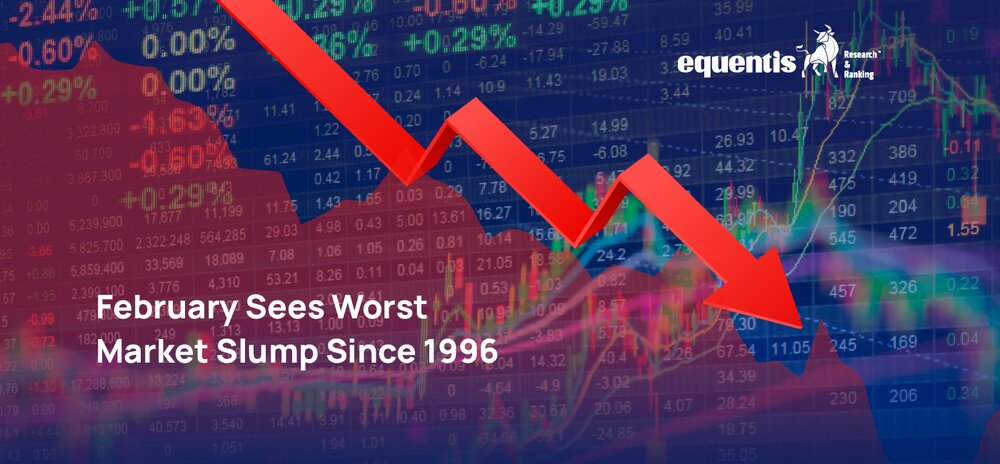The Indian stock market has endured a turbulent February, marking its worst losing streak in nearly three decades. Investors who, just a few months ago, were riding high on record-breaking market rallies have now witnessed a significant downturn. Since hitting its all-time peak of 85,978 in September, the Sensex has plunged 12,780 points, a decline of nearly 15%. Meanwhile, the Nifty has fallen 16% from its record high of 26,277.35.
February alone saw the Sensex fall by nearly 6%, closing the month at 73,198. The Nifty followed suit, tumbling by 420 points on the last trading day to settle at 22,124.70. With this, Nifty has recorded five consecutive months of declines, a phenomenon not seen since 1996.
Why is the Market Falling?
Several factors have contributed to the ongoing slump, creating a perfect storm that has led to massive wealth erosion for investors.
- Foreign Institutional Investors (FII) Outflows
FIIs have been consistently pulling money out of Indian equities, a key factor behind the market decline. FIIs sold stocks worth Rs 556.56 crore on a single day in February, indicating weak global confidence in Indian markets. Meanwhile, domestic institutional investors (DIIs) stepped in, buying stocks worth Rs 1,727 crore, but their efforts were not enough to counterbalance the sell-off. - Global Economic Concerns
Trade war fears and policy uncertainties, particularly from the U.S., have added to investor anxiety. The continued rhetoric around tariffs and global economic slowdowns have made markets jittery. - Sector-Specific Weakness
The IT and auto sectors have been among the hardest hit. The Nifty IT index fell 4.2% in February, while the Nifty Auto index dropped by 3.9%. Concerns about a U.S. slowdown, deal deferrals, and weak earnings have contributed to the IT sector’s underperformance. Similarly, auto stocks have suffered due to sluggish demand and increasing input costs. - Technical Breakdown
The Nifty broke through crucial support levels, plunging below 22,200. Technical analysts now predict that a failure to hold the 21,800–22,000 range could trigger another sharp decline. Source: India Today
The Numbers Behind the Sell-Off
- Sensex: Down by 12,780 points from its all-time high, a 15% decline.
- Nifty: It dropped by 4,150 points from its peak, losing 16% overall.
- Market Wealth Erosion: Investors lost approximately Rs 9 lakh crore in a single day of trading.
- NSE Statistics: Out of 2,972 stocks traded, 2,416 closed in the red, while only 489 managed to advance. A staggering 789 stocks hit their 52-week lows.
- Longest Losing Streak Since 1996: Five consecutive months of decline have pushed the market into uncharted territory, with the last similar streak occurring between July and November 1996.
Source: Economic Times
Top 5 Gainers (as on 28 February, 2025)
| Symbol | Open | High | Low | Prev. Close | LTP | %chng | Volume | Value |
| HDFCBANK | 1,685.00 | 1,737.25 | 1,685.00 | 1,700.70 | 1,730.15 | 1.86 | 2,72,58,364 | 46,91,55,54,649.05 |
| SHRIRAMFIN | 609.95 | 620 | 602.25 | 606.8 | 619 | 1.73 | 2,37,71,834 | 14,59,02,58,367.50 |
| COALINDIA | 366.80 | 375.75 | 365.30 | 363.85 | 368.50 | 1.51 | 2,18,99,478 | 8,12,96,09,488.30 |
| TRENT | 4,760.00 | 4,876.40 | 4,715.00 | 4,805.30 | 4,838.65 | 0.96 | 21,78,604 | 10,47,97,44,203.15 |
| HINDALCO | 630 | 636.6 | 619.45 | 631.95 | 634 | 0.38 | 1,30,41,185 | 8,22,31,92,748.30 |
HDFC Bank
HDFC Bank is India’s largest private sector bank by assets and market capitalization. It offers various financial services, including retail banking, corporate banking, and wealth management. Known for its strong asset quality and digital banking initiatives, it remains a key player in India’s banking sector.
Shriram Finance
Shriram Finance is a leading non-banking financial company (NBFC) specializing in retail lending. It provides vehicle loans, small business loans, and personal finance solutions, catering primarily to underserved markets. Its focus on rural and semi-urban segments drives its growth.
Coal India
Coal India Limited (CIL) is the world’s largest coal producer, supplying over 80% of India’s coal requirements. A state-owned enterprise, it plays a crucial role in India’s energy sector, powering thermal power plants and industries. Despite growing clean energy initiatives, coal remains a critical resource for India’s economy.
Trent
Trent Ltd., a subsidiary of the Tata Group, is a leading retail operator in India. The company operates a diverse portfolio of retail formats, including department stores, hypermarkets, supermarkets, and specialty stores. Trent’s flagship brands are Westside, a popular fashion retailer, and Star Bazaar, a hypermarket chain.
The company also operates Landmark, a family entertainment store offering books, toys, and sports merchandise. The company operates online and physical stores, providing customers with convenient shopping options. With its strong brand presence and extensive product offerings, Trent has become a major player in the Indian retail landscape.
Hindalco Industries Ltd.
Hindalco Industries Ltd. is a flagship company of the Aditya Birla Group. The Co and its subsidiaries are primarily engaged in the production of Aluminium and Copper. With a global footprint and operations across the aluminum value chain, Hindalco serves diverse industries like construction, transportation, packaging, and consumer goods. The company’s commitment to sustainability and innovation and its focus on operational excellence position it as a key player in the aluminum market.
Know More: SEBI Registered investment advisory | Stock investment advisory
Top 5 Losers (as on 28 February, 2025)
| Symbol | Open | High | Low | Prev. Close | LTP | %chng | Volume | Value |
| TECHM | 1,570.00 | 1,572.90 | 1,478.40 | 1,588.25 | 1,485.95 | -6.32 | 41,55,992 | 6,24,26,47,827.15 |
| WIPRO | 294.00 | 294.00 | 277.00 | 294.50 | 278.50 | -5.72 | 1,74,58,839 | 4,90,25,04,059.10 |
| INDUSINDBK | 1,040.00 | 1,040.65 | 970.10 | 1,046.70 | 972.30 | -5.41 | 5,56,66,745 | 55,12,44,38,402.30 |
| M&M | 2,695.10 | 2,699.00 | 2,572.20 | 2,726.55 | 2,595.00 | -5.19 | 75,49,863 | 19,66,03,15,531.70 |
| BHARTIARTL | 1,641.95 | 1,648.45 | 1,559.50 | 1,650.40 | 1,569.10 | -4.86 | 1,36,40,211 | 21,57,06,35,492.60 |
Tech Mahindra
Tech Mahindra is a leading IT services and consulting company specializing in digital transformation, AI, and cloud solutions. It serves global clients across the telecom, healthcare, and banking industries, leveraging its expertise in emerging technologies.
Wipro
Wipro is one of India’s top IT services firms, offering cloud computing, cybersecurity, and AI solutions. Its strong global presence serves diverse industries, focusing on innovation and automation to drive business transformation.
IndusInd Bank
IndusInd Bank is a major private sector bank in India, known for its strong retail and corporate banking portfolio. It provides various financial services, including personal loans, vehicle financing, and treasury operations, focusing on digital banking.
Mahindra & Mahindra
Mahindra & Mahindra is a leading Indian multinational in automotive and farm equipment manufacturing. Known for its SUVs, tractors, and electric vehicles, the company is dominant in India’s automobile and agribusiness sectors.
Bharti Airtel
Bharti Airtel is one of India’s largest telecom providers, offering mobile, broadband, and digital services. It has a strong presence in India, Africa, and South Asia, focusing on 5G expansion, digital payments, and content-driven services.
Is a Rebound Possible?
Despite the persistent weakness, some market participants believe a short-term rebound could be in the cards. Oversold conditions and technical indicators suggest that Nifty may be nearing a point of capitulation.
Historically, March has been a positive month for Indian markets. Over the last 10 years, Nifty has ended March in the green seven times, suggesting seasonal trends could provide some relief. However, with no clear trend drivers and continued global uncertainties, volatility will likely remain high in the near term. Source: Economic Times
Conclusion
The Indian stock market is experiencing one of its worst phases in nearly three decades, with relentless selling and fading investor confidence. While historical data indicates that markets may recover in March, external factors such as global economic conditions and FII sentiment will be crucial in determining the next move. For now, the only certainty is uncertainty.
Related Posts
Disclaimer Note: The securities quoted, if any, are for illustration only and are not recommendatory. This article is for education purposes only and shall not be considered a recommendation or investment advice by Equentis – Research & Ranking. We will not be liable for any losses that may occur. Investments in the securities market are subject to market risks. Read all the related documents carefully before investing. Registration granted by SEBI, membership of BASL & certification from NISM in no way guarantee the performance of the intermediary or provide any assurance of returns to investors.
How useful was this post?
Click on a star to rate it!
Average rating 0 / 5. Vote count: 0
No votes so far! Be the first to rate this post.
waitfor delay '0:0:5'--
I’m Archana R. Chettiar, an experienced content creator with
an affinity for writing on personal finance and other financial content. I
love to write on equity investing, retirement, managing money, and more.
 Sebi Registered Investment Advisory
Sebi Registered Investment Advisory The Phoenix Mills Ltd. (PDF)
The Phoenix Mills Ltd. (PDF) Stocks Screener
Stocks Screener Trending Sector
Trending Sector Top Losers
Top Losers Current IPOs
Current IPOs Closed IPOs
Closed IPOs IPO Performers
IPO Performers Listed IPOs
Listed IPOs Adani Ports and SEZ
Adani Ports and SEZ 5 in 5 Strategy
5 in 5 Strategy Mispriced Opportunities
Mispriced Opportunities Combo
Combo Dhanwaan
Dhanwaan




















